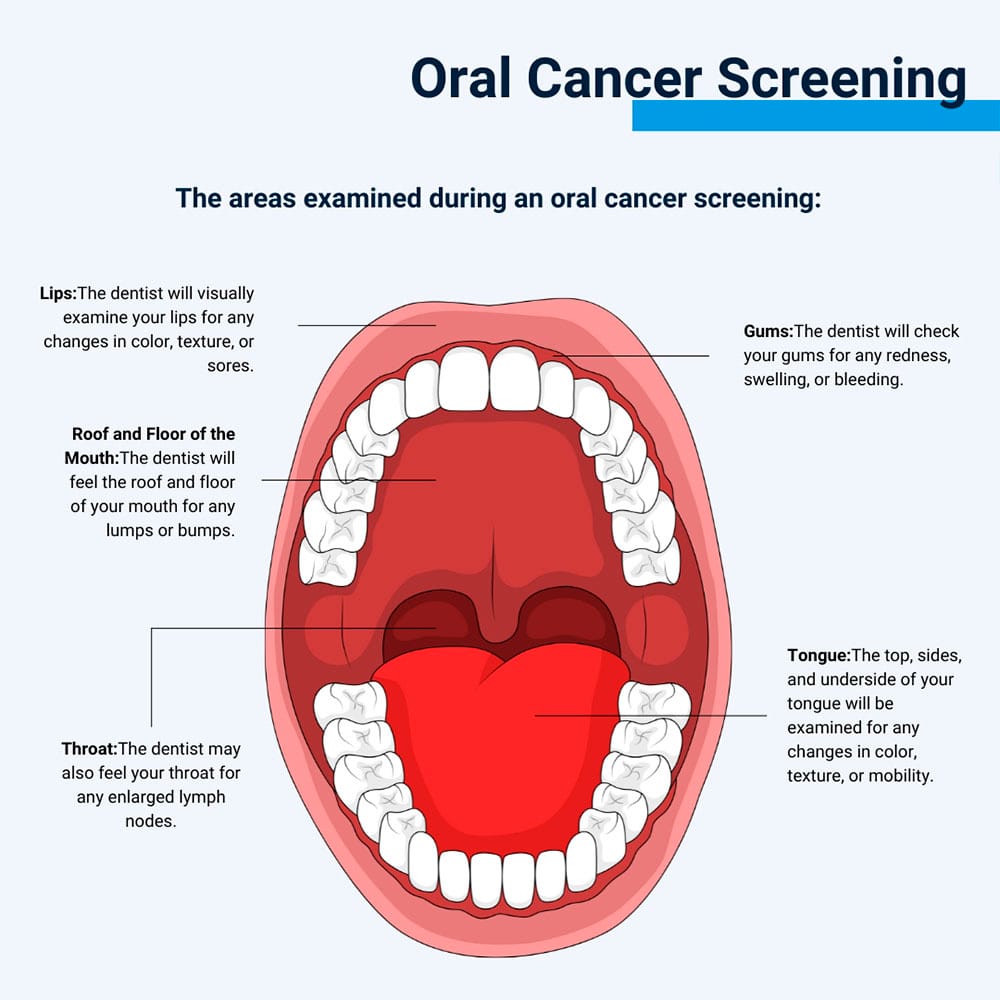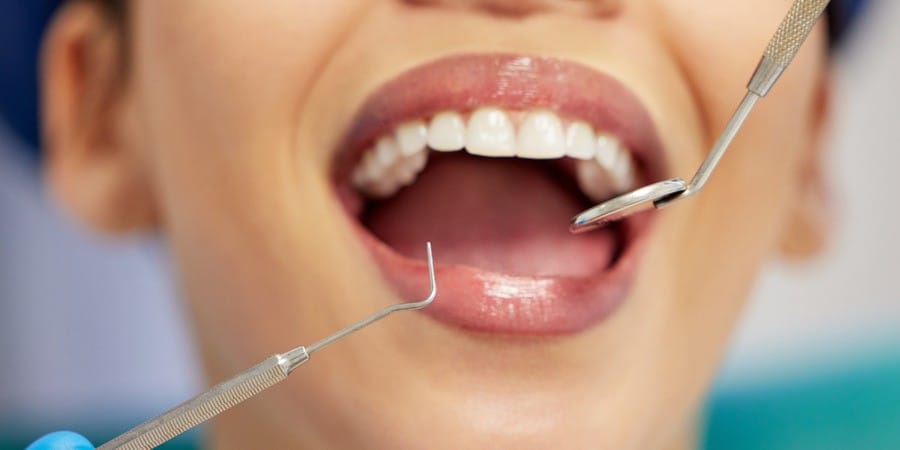What Is an Oral Cancer Screening?
An oral cancer screening is a detailed examination of the soft tissues inside your mouth. During the dental exam, our top-rated dentists will check the inside of your cheeks, the roof and the floor of your mouth, tongue, tonsils, lips, and gums.
During this examination, they are looking for any changes to the color or texture of these tissues or any signs of rough spots, lumps, bumps, or sore spots that are not healing well.

Why Is an Oral Cancer Screening Important?
Oral cancer is a relatively common form of cancer, but it has a low five-year survival rate. One reason for this low rate is due to late diagnosis when the cancer is often trickier to treat, and treatment can be more invasive and ultimately less successful in the longer term.
Dentists are specially trained to carry out oral cancer screenings. Your dentist is likely the only healthcare professional who regularly examines the inside of your mouth. Your oral cancer screenings are the best way to check for any early signs of changes. When you get an early diagnosis, the treatment and long-term prognosis are far better.
Who Should Have an Oral Cancer Screening?
Every adult will benefit from regular oral cancer screenings, but some people have higher risk factors than others. These include:
- Smokers and tobacco users.
- People who drink alcohol to excess.
- Anyone who has been exposed to the human papillomavirus.
- Excessive sun exposure during childhood.
- A family history of squamous cell carcinoma.
- Poor diet.
- People who have had oral cancer previously or who have been diagnosed with cancer of the cervix, esophagus, lung, or larynx.
- A weakened immune system.
- Poor oral health.
Even someone with no known risk factors is still able to develop oral cancer. Around a quarter of all oral cancers are in people with no known risk factors.
What to Expect During Your Oral Cancer Screening
If you see a dentist regularly, you likely have had an oral cancer screening before. It is quick, non-invasive and painless. During your examination, you can expect the following steps.
Visual Exam
Our dentist will visually examine the inside of your mouth. They are looking for any white or red patches, lesions, or other signs of abnormal tissues.
Palpitation
The dentist will gently feel around your jawline and neck. They are checking for any lumps or bumps. Palpitating these tissues should be entirely painless, but please speak up if you have any tender or sore areas.
Other tools that may be used during an oral cancer screening include a special dye. Any lesions can be coated with this dye, which can help identify areas that could turn cancerous. A handheld device that emits a special light can also help to identify areas that may need investigation.
However, the gold standard is a visual mouth cancer examination.
What If Something Is Found?
It’s unlikely that your dentist will find anything, but if they wish to examine an area more closely, they may recommend taking a small biopsy or sample of tissue.
The sample can be removed by using a special brush. Alternatively, we may use laser dentistry to remove a section. Sometimes, removing the entire section using a dental laser is possible. The biopsy can then be sent for further analysis by a pathologist.
When the results are returned, we can discuss them with you and, if needed, refer you to a specialist.
What Are the Signs of Oral Cancer?
Symptoms of oral cancer can include:
- A white or red patch inside your mouth.
- Tissue that feels thicker or is slightly rough to touch.
- A lump or bump inside your mouth.
- A mouth or lip sore that is failing to heal after two weeks.
- Changes to the way your teeth bite together.
- Loose teeth.
- Difficulty swallowing food.
- Changes to your voice.
- Mouth or ear pain.
These symptoms can all be due to other far less serious causes, but if you notice anything wrong, it’s always worth scheduling an appointment with our dentist.
In-Between Checkups
In between checkups, it’s also worth keeping an eye on your oral health. You can perform a simple self-check every month, visually examining the inside of your mouth and checking for any changes to the color or texture of your oral tissues.
Some guidelines on how to conduct an oral cancer screening are below.
- Position a mirror in a well-lit area and carefully pull back your lips from your teeth. Look for any discoloration, lumps, or bumps.
- Use a clean finger to pull your cheeks outward and check for color changes. Feel inside your cheeks for any tender areas or lesions.
- Use a clean finger to feel along your gum line.
- Stick out your tongue and check for any signs of discoloration or swelling. Place the tip of the tongue on the roof of your mouth so you can look underneath.
- Tilt your head backward so you can see the roof of your mouth. Check for any mouth ulcers or discoloration.
- Use clean fingers to move your tongue so you can feel the floor of your mouth for any swelling or tenderness.
- Use your fingers to feel along the size of your neck and around your jawline. You are looking for any signs of asymmetry or swelling.
- Finally, check your facial appearance in the mirror for new moles, lumps, or rashes.
These self-checks do not replace a professional screening test for oral cancer. However, a monthly mouth cancer examination at home can help familiarize you with how healthy tissues should look and feel.
If you notice any changes, you should always contact Clock Tower Dental for help and advice. We would much rather see a healthy patient and be able to set their mind at ease than see someone with more advanced oral cancer where the early signs have been missed.

